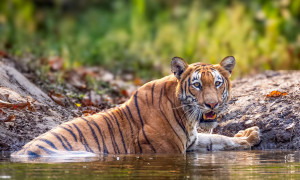Books
When rivers breathe and speak
Before his passing in 2024, political thinker James C Scott wrote a radical ode to floods, arguing that taming rivers does more harm than good.
Pawan Khanal
Rivers are alive and dynamic, and they should no longer be viewed merely as bodies of flowing water but as living entities.
They share many living characteristics: they breathe, move, are born, and die, argues James C Scott, professor of Political Science at Yale University. ‘In Praise of Flood’, Scott’s last book completed before his death in July 2024, challenges conventional wisdom built around crucial interactions between rivers and human lives.
Scott unfurls how our collective imaginings and history with rivers as a destructive force and a source of sorrow have led to an undesirable standoff. From the example of the Yellow River in China, Scott demonstrates how the desire to tame mad rivers and drain the swamps can ultimately be wasteful. In its journey of about 5,500 kilometres, the Yellow River, often known as ‘China's Sorrow,’ deposits a massive amount of sediment in its floodplain. A high depositional rate and the low gradient of its floodplain caused the river to change its path as much as 800 kilometres in 300 years.
Centuries of effort to tame the chaotic Yellow with walls and levees have caused its sediments to pile on in a very narrow stretch, leading to a rise in the water level.
While settlements around the river have only gotten denser, the Yellow, in some parts today, flows more than 15 metres above its floodplain. Overall, a flood in a tamed Yellow today carries more consequences than a flood in a free Yellow that once was. If it wants to free the river, China is locked in, facing massive sunk costs of relocating the settlements around the Yellow River. The book shows how viewing rivers as destructive and acting to tame them creates a positive feedback loop with increasingly dire consequences.
Similarly, highlighting the dynamism of rivers, the author brings examples of how the Amazon widens to 40 times more than its normal size during floods and writes that rivers constantly change their course and size, which are their essential characteristics. Stretching the temporal and spatial horizons is imperative to see floods as natural and life-giving. Devastating floods occur only when this well-established fact is overlooked.
In another sense, Scott argues that all attempts to tame rivers as neat lines on the map have produced pyrrhic victories. As a result, many modern development initiatives and engineering designs have failed to foster sustainable development as they fail to recognise the importance of life-supporting ecosystem forces that floods bring.
The goal, Scott contends, should be not to prevent floods but to embrace them. Nepal, too, has several examples of such pyrrhic victories and engineering attempts to curb the natural river flow. Numerous local efforts are made in good faith every year to protect a part of a settlement without holistically looking at the entire scheme of river flow and appreciating their free movements. A recent LinkedIn newsletter from Nitesh Sharma highlights an emblematic story in Ward 3 of Babardiya: an embankment that protects a settlement upstream can induce flooding in other downstream areas.
Scott warns that unfounded engineering measures only lay the ground for more wild and catastrophic floods. He encourages a soft-path approach to development. For rivers, this means taking in a holistic view that appreciates floods as natural river breaths. Nature-based solutions offer examples of such an approach to co-existing with ‘wild’ rivers. This can transform tragedies like the one in Baniyabhar into something wonderful.
Indeed, floods are wonderful, argues Scott. When water runs over flood banks, it brings much-needed silt-rich sediment to nourish the soil and allow fish and crustaceans to access biotas. When the waters recede, the floods leave behind precious backwaters, ponds, swamps, marshes, and many other riverine features. Floods are essential not only to our agricultural lands but also fundamental to the existence of riverine species and the livelihoods they foster.
Giving human voices to different riverine species in the Ayeyarwady River, the principal river in Myanmar, Scott’s idea culminates in what he terms as interspecies riverine democracy. In this political system, each riverine species has the same voice as ours, even if they do not share the same language. Translated into law and policy, the idea closely resembles the Rights of Nature movement, explored in an equally wonderful book, ‘Is a River Alive?’, by Robert Macfarlane.
Beyond ecological benefits, floods also shape social values, belief systems, social structures, and cultural practices. The book documents how nats (river spirits) of the Ayeyarwady River promote sustainable use and consumption of river resources among its people. An illustrative example is that of the locals who refrain from engaging in inappropriate behaviours in the vicinity of the shrines around the river, such as urinating, as they believe such actions could provoke the ire of these deities. In the context of species conservation, nga-yew fish (a predatory catfish with the strength to tear down fishing nets) have nat worship to thank for their existence. As they are regarded as nat-fish, people have learned to put up with their frustrations and return these ‘troublemakers’ into the river even if caught. These animist practices also help improve community relations, as various rites and rituals centred around pleasing nats create a culture of sharing and giving back.
The idea of praising floods and free rivers is perhaps encapsulated beautifully by Scott’s analogy that sees rivers as akin to us. Just as we are animated, in part, through oxygenated blood that nourishes our bodies with every pulse, every river, in part, is animated by a flood pulse that nourishes the different parts of its body. The author’s end message is that if humans want rivers to understand our essential condition for existence, we must realise theirs. Each river has a tune, a hymn, a beat through which it sways and dances. Putting on earmuffs does not stop the music, nor does it stop their dance.




 25.43°C Kathmandu
25.43°C Kathmandu
















